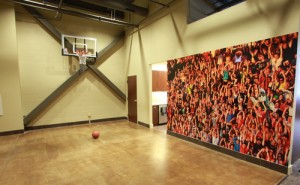 |
| WANT TO PLAY HORSE? Creative-economy firms like Lambert Edwards & Co. are finding downtown Detroit locations to be a powerful lure for young employees – and raw space that can be remodeled for 21st-century office amenities. (Courtesy photo) |
The Southeast Michigan office of Grand Rapids-based public relations firm Lambert Edwards & Co. had been located for years in a gleaming high-rise Troy tower, surrounded by a sea of asphalt parking lots and clogged highways.
“You couldn’t walk out your door to get a sandwich,” President Jeff Lambert said. “It was sort of an outmoded office environment.”
So earlier this year, Lambert relocated his office and the 15 people working there to what had been an abandoned retail storefront in a city many businesses once feared to tread—Detroit.
“There’s a business cheerleading section in downtown Detroit and we’re excited to get caught up in it,” he said.
Dozens of companies, many of them in creative industries such as advertising, architecture and design, are flocking to central-city Detroit in a surprising reversal of the mass exodus to the suburbs that took place during the past half century.
They say they are moving to Detroit to attract young workers who want to live and work in cities, and to attempt to revitalize a city that was abandoned by a previous generation of businesses.
Even Whole Foods, the upscale food retailer, is opening a new store next week in the Midtown section of what has long been one of the nation’s poorest, most crime-ridden cities.
“I’ve been here 16 years and this is the biggest burst of development in Detroit I’ve seen in that time frame,” said David Egner, executive director of the New Economy Initiative for Southeast Michigan.
Egner’s group has raised $100 million from area foundations and is investing it in entrepreneurial ventures in the city and surrounding region.
While a reviving core city is generally seen as good economic news for the Southeast Michigan region, if not the entire state, there is little data on business formation occurring in Detroit.
And some say much of Detroit’s business growth is coming at the expense of the suburbs, amounting to a zero-sum game.
Quicken Loans founder Dan Gilbert, who gets much of the credit for breathing new life into downtown Detroit, moved his company and its 1,700 jobs from Livonia to Detroit in 2010.
Since then Quicken and its family of companies have moved more than 8,000 jobs to the city.
Blue Cross Blue Shield of Michigan last year transferred 3,000 workers from Southfield to the Renaissance Center in Detroit.
And advertising agency Campbell Ewald said in March it will move its headquarters from suburban Warren to a former J.L. Hudson Co. warehouse next to Ford Field in January. The move will shift 600 jobs from Warren to Detroit.
“I’m glad to see Detroit is back in business. I just wish it was recruiting businesses from out of state rather than the county next door,” said Oakland County Executive L. Brooks Patterson, who has long had a contentious relationship with the city.
“The suburbs are doing their part to help Detroit,” he quipped.
Even the threat of the financially troubled city filing for bankruptcy isn’t stopping business owners from investing in Detroit.
“I think I and many others in the business community have a tremendous ability to compartmentalize,” Lambert said. “We have to be optimistic to survive.”
By one measure, Detroit’s central business district appears to be prospering at the expense of the suburbs.
A report by real estate broker CBRE Inc. in Southfield said that 47,021 square feet of office space in Detroit’s central business district had been occupied in the first three months of this year.
But a net 29,760 square feet of space was vacated during the same period in the suburbs, according to the report.
Downtown Detroit’s office vacancy rate at the end of March was 23.3 percent, compared to 27.2 percent in the suburban market.
And the asking price for office space in downtown Detroit was $18.53 per square foot in March, $2.01 a square foot higher than in the suburbs.
“Tenants continue to have an urban preference as they look to appease a youthful workforce,” the CBRE report said. Still, the suburban office market, with 58.8 million square feet of space, is more than three times larger than Detroit’s 16.3 million square feet.
And demographic experts say there is no reliable data available on how many businesses are located in Detroit and how many have moved there in recent years.
The little employer data that is collected is held by the state and not shared with independent demographers and local officials, said Kurt Metzger, director of Data Driven Detroit.
Such data could help government officials and economic developers gain a better understanding of the dynamics of the city’s business activity.
“No one has put in the systems necessary to track the data that should be readily accessible,” Metzger said.
The Census Bureau’s economic census tracks the number of business establishments by locality. But the bureau won’t start releasing data from the census until the end of this year.
A report released in February by the Hudson-Webber Foundation offers a snapshot of what’s been happening the Detroit’s major business district in recent years.
The report says there has been $6 billion worth of real estate projects built in the greater downtown area since 2006. It also forecast that “creative companies” such as Campbell Ewald will add another 1,750 jobs by 2017.
Click HERE for the full article!



0 comments:
Post a Comment